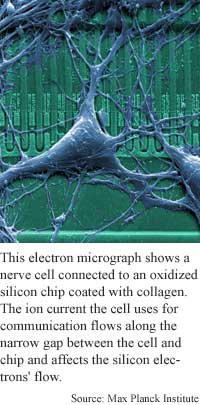
Neuron-chip link advances
By Kimberly Patch, Technology Research NewsThe differences in biological versus electronic communications are far beyond Mars/Venus comparisons.
Cells communicate when ions suspended in water flow through membranes, while signals pass among electronic components when electrons flow through solid metal or semiconductor. Electrons flow through silicon and metal about 100 billion times faster than ions flow through water. And there's also a considerable size problem: cellular ion channels, at about 3 nanometers in diameter, are smaller than today's tiniest electronic components.
A direct ion channel-electronic interface, however could eventually prove useful in biosensors, brain-computer interfaces, or even open up the possibility of neural prosthetics.
Although devices that combine biology and electronics -- like pacemakers and cochlear implants -- exist today, the electronics are too large to actually interface with ion channels.
Researchers from the Max Planck Institute for Biochemistry have taken a step toward more specific biological-electronic communications with a device that allows a field effect transistor on a silicon chip to sense the electric potential created by a nerve cell, and the nerve cell to sense a voltage pulse in the chip.
The researchers cultured the cells on an oxidized silicon chip coated with collagen. The cell's ion current flowed through the cell membrane and then continued along the narrow gap between the cell and the chip. This gap current gave rise to a voltage drop that changed electron flow in the silicon on the other side of a thin insulating oxide layer.
In this way, "the elementary electrical current of the cell [was] translated into a charge of electrical current in the chip without current flow across the interface," said Peter Fromherz, a professor of biophysics at the at the Max Planck Institute for Biochemistry in Germany.
The setup is in essence a direct connection of ion channels in a cell membrane with the electron channel, said Fromherz. An ion is an atom that carries electric charge because it has lost or gained one or more electrons. A neuron fires when it collects enough ions to build up a substantial electric charge, or potential on the inside of the cell.
The researchers also took the communication a step further by creating a feedback loop where the current modulation triggered the chip to pass a voltage pulse to a stimulation spot in the neuron, which made it fire again.
The researchers also used a pair of neurons connected both to each other and to the chip to perform this feedback loop sequentially and in parallel.
The neuron-chip device is smaller and the method more precise then existing ion-electron converters that connect electrodes to cells and allow current flow across the interface, said Fromherz. It is also different because it directly integrates a transistor with a biological component.
The researchers' device "talks directly with these ion channels, a new step down in size and step up in precision," said Richard Granger, a professor of information in computer science at the University of California at Irvine and CEO of Thuris Corporation, a neurotechnology company. The work "foreshadows incipient conversations between devices and living tissues," he said.
Granger cautioned, however, that there are many steps between this research and practical ion channel-computer chip communications. The research has "advanced understanding of how we might talk to neurons, but we still do not know what neurons say to each other, nor even what language they use."
The research, ironically, may eventually help with the language problem, said Granger. "Bioelectronic interfaces for the brain may enable us to listen to brain circuits before we can translate what they say," he said.
The researchers next steps are to improve the interface and to try to control the ion channels from the computer chip, said Fromherz.
There are two classes of biological ion channels. One type is controlled by voltage, the other type is opened when a special type of molecule, a ligand, binds to a receptor from outside the cell. The researchers also have plans to control the second type of channel, which could lead to devices that could sense biological, environmental or pharmaceutical agents.
"We shall replace the voltage sensitive... channel by ion channels that are sensitive to biological antagonists or to related pharmacological agents. In these ligand-gated channels the channel itself is coupled to a chemical receptor," said Fromherz.
For instance, one important ligand-gated channel is the glutamate receptor in the synapses of the brain, where glutamate molecules open a communications channel by binding to the membrane. This channel is the target of numerous pharmacological agents, said Fromherz.
The interface could be used to design pharmacological biosensors within five years, said Fromherz. Neurocomputers and neural implant devices are more than 20 years away, he said.
Fromherz's research colleagues were Bernhard Straub and Elisabeth Meyer of Max Plank Institute for Biochemistry. They published the research in the February, 2001 issue of Nature Biotechnology. The research was funded by the Max Plank Society and the German Federal Ministry of Education and Research.
Timeline: 5 years, > 20 years
Funding: Government, Private
TRN Categories: Human-Computer Interaction; Neural Networks; Integrated Circuits
Story Type: News
Related Elements: Technical paper, "Recombinant Maxi-K Channels on Transistor, a Prototype of Iono-electronic Interfacing," Nature Biotechnology, February, 2001.
Advertisements:
March 7, 2001
Page One
Neuron-chip link advances
Electricity moves fluids
Quantum effect makes fast connections
Chain reaction yields microscopic wires
Noise can bring quiet surprise

News:
Research News Roundup
Research Watch blog
Features:
View from the High Ground Q&A
How It Works
RSS Feeds:
News
Ad links:
Buy an ad link
| Advertisements:
|
 |
Ad links: Clear History
Buy an ad link
|
TRN
Newswire and Headline Feeds for Web sites
|
© Copyright Technology Research News, LLC 2000-2006. All rights reserved.